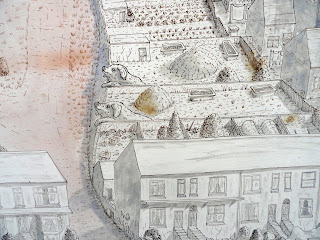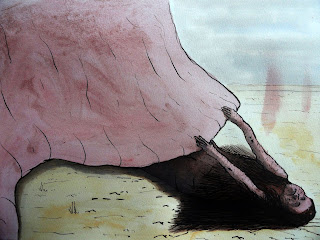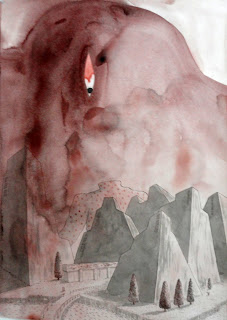I use ink all the time and have in the past made oak gall ink (also known as iron gall ink) myself. I use dip-in pens almost every day and for the past thousand years oak gall ink was the dip-in pen liquid of choice. It was only with the introduction of fountain pens that the use declined, mainly because oak gall ink deposits silt and corrodes metals which makes it totally unsuitable for modern pens.
I have posted several times about media specificity and that I like to think of this in two ways. On the one hand there is a purely physical set of issues surrounding what you can do with the material. In this case how does it flow, what is its covering power, how does it stick to other surfaces, what is its colour range? etc. On the other hand there is the what I have called 'ur' history of things. How was it made, who made it, from what and how does this effect other things, such as a local economy, sustainability or other wider impacts. However in the case of oak gall ink, there is also a very powerful cultural set of associations because so many famous drawings were made using it. It is 'hot' with art historical interest, as are other materials such as oil paint, marble or charcoal and it is embedded deeply into the narratives surrounding art practice. Most of the artists that we would regard as 'canonical' at one time or another used oak gall ink; often using pen and ink for linear qualities, together with brushwork for tonality. Unlike other drawing materials such as charcoal and chalk, you can't rub out what you have done afterwards, therefore in many ways pen and ink drawings are seen as much more direct records of an artist's thought and therefore could be read as being closer to the centre of certain Romantic ideas about art and artists, especially those concerned with the spontaneity of an artist's vision.
Oak gall ink has four ingredients: dried oak galls, ferrous sulphate, gum arabic and water. Each of which can be thought of as carrying a series of associations potentially just as potent as those linked to images of past oak gall ink drawings.
Goya
Rembrandt
Oak galls are formed when a gall wasp lays an egg into a puncture on the underside of an oak leaf. As the larva develops, the tree secretes tannic and gallic acids, creating a round formation known as a gall nut or oak apple. These are what you need to harvest.
Oak gall with hole formed by escaping wasp
This is a basic recipe for oak gall ink:
Collect as many oak galls as you can or buy them on line. Put them somewhere warm to dry out. After drying, wrap in a cloth and hit with a hammer to break the galls down into manageable sizes and then finely crush the oak gall fragments using a mortar and pestle.
Using four ounces of crushed oak galls, pour over two pints of water and soak for 24 hours. Strain the oak gall/water mixture through cheesecloth to remove surplus bits of crushed oak galls. Add two onces of ferrous sulphate to the oak gall solution. Mix well. Add one once of powdered gum arabic and continue to stir. Leave for 24 hours. Because the pigment in iron gall ink does not go fully dark until it is exposed to air for a while, it is rather light when applied to paper immediately after preparation. Therefore artists sometimes added other ingredients into the mix and everything from red wine to natural wood dyes have been added to the basic solution in the past. Bear in mind that iron gall ink is corrosive. As the ink ages, it will release acidic materials which can damage writing instruments and preparation equipment over time. Be sure to rinse pens, brushes, cooking and mixing tools immediately after use.
Piranesi
Because oak gall ink corrodes metals it was often used with quills or in Van Gogh's case the reed pen. It is perhaps with Van Gogh that we find the relationship between writing and drawing at its most intimate, his letters move between writing, drawing and painting, at times a colour is simply inserted as a word, bleu for the sky in the case below, and the rhythm of his writing becomes set off alongside the rhythm of his drawing strokes. I saw Van Gogh's letters alongside his drawings for the first time at a wonderful exhibition at the Hayward Gallery in 1968. The letters in many ways brought home to me the democratic nature of his art, it was something I could do, something for all of us to aspire to. The most profound art could be made out of the communication between two human beings, in this case Van Gogh and his brother Theo.
Van Gogh
If you do get interested in this sort of drawing it is really worthwhile to make your own pens. See how to make a reed pen and how to make a quill pen. You may even go on to make your own brushes.
Watch this video to see what oak galls look like and how to operate in the wild.
Those of you interested in sustainability and wanting to make a point about how we ought to be co-existing with nature may want to make your own materials. If so make sure you document the process, it may be that the artwork that you are producing needs to include the various activities that are brought together in the creation of inks, nibs, brushes etc. and that these can be regarded as special types of journeys both into craft and into various ideas of nature. My own interest lies in trying to listen to other 'voices', how do I begin to understand the language of my materials if I have never thought about how they come into being. As you draw with this ink, you are in many ways extending a conversation that begins with a tree and a wasp.
I must however end this post with a warning. It has been suggested that oak gall ink corrosion is a serious threat to the cultural heritage of western society. It is very corrosive and so thousands of manuscripts and drawings in libraries and museums are in danger of being lost because over time it eats away into the paper it was drawn on. Personally I think this is another very interesting story, one about the excessive pride of human beings and a story that resonates more and more as we enter the age of the anthropocene.
If it all sounds too hard to do, here are a couple of other ways to think about making inks:
Stuff like onion skins, black walnuts, coffee, tea etc. don’t need mordants, so just boil up these things with water and try them out. N.b. A mordant is an inorganic oxide that will combine with a dye or stain and thereby fix it. Other stuff does need a mordant, usually soda ash or rusty iron, so try anything and see if either of these works. Again try different organic materials.
Stuff like onion skins, black walnuts, coffee, tea etc. don’t need mordants, so just boil up these things with water and try them out. N.b. A mordant is an inorganic oxide that will combine with a dye or stain and thereby fix it. Other stuff does need a mordant, usually soda ash or rusty iron, so try anything and see if either of these works. Again try different organic materials.
For lamp black collect soot from a burning candle or ask if someone has a chimney that still needs sweeping. Bind by mixing together egg yolk, gum arabic, and honey and stir in the lamp black. To use the ink, mix this paste with a small amount of water to achieve the desired consistency.
Add thyme oil to stop mould forming.
See also:Why ink sticks to paper
Thinking about an ink drawing
Thinking about the role of non-human agents in communication


























































